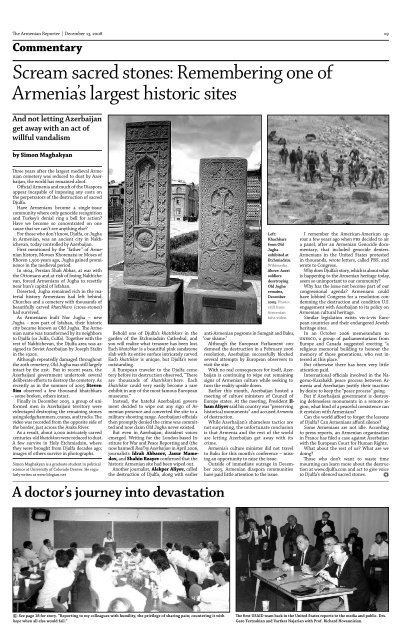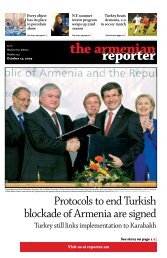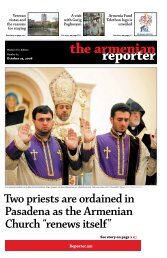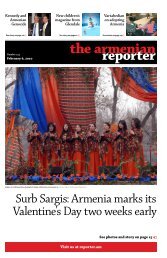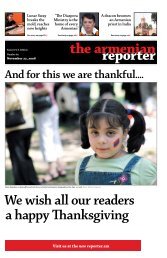18 The <strong>Armenia</strong>n Reporter | December 13, 2008EditorialCommentarythe armenianreporterConfronting mass atrocities 60 years after theUnited Nations Genocide ConventionOn this 60th anniversary of the passage of the United Nations Convention on the Prevention<strong>and</strong> Punishment of the Crime of Genocide, the prevention of genocide is emerging as animportant issue for the political <strong>and</strong> media establishment. For this we are grateful.The President-electThe president-elect, Barack Obama, has made a point of selecting an outspoken advocateof action against genocide, Susan Rice, as the next U.S. permanent representative to theUnited Nations.During the presidential campaign, Mr. Obama said repeatedly that he had a principledcommitment to genocide prevention, <strong>and</strong> that as president he would act to end the genocidein Darfur. The selection of Ms. Rice is a sign that Mr. Obama takes this commitment veryseriously.The taskforceA high-profile project started last November, the Genocide Prevention Task Force, has issuedits final report, Preventing Genocide: A Blueprint for U.S. Policymakers. The report includes aset of sensible recommendations directed at the president, the Congress, the Americanpeople, <strong>and</strong> the national-security establishment.The recommendations call for early warning <strong>and</strong> early engagement before genocide is undertaken;preventive diplomacy; the availability of military options; as well as strengtheninginternational norms.We welcome the report as a positive step forward.The taskforce began with a h<strong>and</strong>icap: the identity of its co-chairs. The co-chairs, formersecretary of state Madeline Albright <strong>and</strong> former secretary of defense William Cohen, onthe eve of their appointment to this taskforce signed a letter urging Congress not to adoptthe <strong>Armenia</strong>n Genocide resolution. Asked on 60 Minutes on May 11, 1996, whether she wastroubled by the fact that sanctions on Iraq in the Clinton era may have resulted in the deathof 500,000 Iraqi children, Ms. Albright had replied callously, “I think this is a very hardchoice, but the price – we think the price is worth it.”Thus, the taskforce had a credibility gap to overcome.Did it overcome that credibility gap? On the negative side, the report is deliberately ahistorical;that is to say, it avoids history. While the authors necessarily draw on the lessons of history, theydo not do so explicitly. The words Jew <strong>and</strong> gypsy do not occur in the final report even once; <strong>and</strong>the report makes only passing references to the <strong>Armenia</strong>n Genocide <strong>and</strong> the Holocaust.Preventing genocide “starts with acknowledging the tragic instances of genocide in worldhistory.” These are the words of Mr. Obama, <strong>and</strong> we agree with them wholeheartedly. Thewillingness to avoid history in order to appease a state benefiting from the fruits of genocide,Turkey, is a bad sign; it means the taskforce has failed to learn probably the biggest lesson ofthe past, that impunity breeds contempt for law. Those contemplating genocide today needto know that they <strong>and</strong> their successors will not be able to sweep their crimes under the rugwhile they enjoy the fruits of those crimes against humanity.On the positive side, the taskforce has further raised the profile of genocide prevention as anational priority. It consulted widely, <strong>and</strong> succeeded in developing sound recommendations.We welcome the final report as a step in the right direction, <strong>and</strong> look forward to workingwithin a broad coalition – the report calls it “a permanent constituency for the prevention ofgenocide <strong>and</strong> mass atrocities” – to build on the recommendations.The CNN documentaryThe effort to build such a “permanent constituency” got a boost from a new CNN documentary,Scream Bloody Murder, which premiered on December 4.As leading voices in that constituency for the prevention of genocide, <strong>Armenia</strong>n-Americansshould welcome the attention of CNN <strong>and</strong> its chief international correspondent, ChristianeAmanpour, who hosts the documentary, to fighting genocide.The documentary puts Ms. Amanpour <strong>and</strong> CNN firmly in the camp of those who recognizethe importance of fighting genocide – <strong>and</strong> not sticking our heads into the s<strong>and</strong>. As we contemplatefuture confrontations between the forces of complacency <strong>and</strong> the “constituencyfor the prevention of genocide <strong>and</strong> mass atrocities,” we are pleased to have these powerfulmedia partners.The documentary movingly <strong>and</strong> effectively focuses on the need for political will to confrontgenocide. It starts, albeit briefly, with the <strong>Armenia</strong>n experience. Outraged by theTurkish state effort to eradicate the <strong>Armenia</strong>n population of the Ottoman Empire, a younglawyer, Raphael Lemkin, coined the word genocide <strong>and</strong> set out to get the world to recognizeit as a crime against humanity, subject to universal jurisdiction. Quoting Mr. Lemkin on thedestruction of <strong>Armenia</strong>ns, a voice in the documentary chillingly intones, “Why is the killingof a million a lesser crime than the killing of a single individual?”The bulk of the documentary, as we reported previously, focuses on recent instances ofgenocide or mass atrocities. These are the stories Ms. Amanpour has covered over the years,<strong>and</strong> she goes back to them to focus on the voices that spoke out <strong>and</strong> screamed “bloody murder.”The question is why, even with the Genocide Convention in place, world powers do littleto prevent <strong>and</strong> stop genocide as it happens.Watching the documentary, we think, of course, of some of the voices that screamedbloody murder in 1915–17. The publication, in 1916, of the British Parliamentary Blue Book,The Treatment of <strong>Armenia</strong>ns in the Ottoman Empire, was an extraordinary development. Evenas the genocide was in progress, an authoritative study systematically brought together verifiedreports from different parts of the Ottoman Empire. It methodically showed the worldcommunity that atrocities against <strong>Armenia</strong>ns were not simply local incidents; they formeda chilling empirewide pattern.Reports written by American consular officials <strong>and</strong> missionaries <strong>and</strong> forwarded by U.S.Ambassador Henry Morgenthau to the State Department form the backbone of the BlueBook. This documented scream of “bloody murder” was heard clearly, <strong>and</strong> the world wasgenerous with humanitarian aid; but as the First World War continued, no one found a wayto stop what Amb. Morgenthau called the “campaign of race extermination.”CNN, through its iReports, allows enterprising citizen-journalists to help it build on itsdocumentary with such compelling stories.The documentary will be airing again in the coming days. If you have not yet watched thedocumentary, we commend it to you.Meanwhile, we call on readers to thank CNN <strong>and</strong> Ms. Amanpour for focusing on genocideprevention <strong>and</strong> for starting, as they should have, with the <strong>Armenia</strong>n experience. Those witha passion for storytelling can use the iReports feature to help CNN build on the documentary.fconnect:http://www.ireport.com/ir-topic-stories.jspa?topicId=155070December 7, 198820 years onA doctor’s journey into devastationDr. VartiterKotcholosianHovannisianmaking anaddress.Photos:Personalarchives ofDr. VartiterKotcholosianHovannisian.See morephotos onp.19. mn Continued from page 17Crescent Societies, while “WHO <strong>and</strong> UNDROquietly left the tragic scene.”When Dr. Hovanissian’s team decided topull out after only six days, she decided tostay. She had been granted a two-week visa<strong>and</strong> now she was faced with being a privateU.S. citizen in a country ravaged by the effectsof a massive earthquake. Taking intoconsideration the unpreparedness of authorities<strong>and</strong> the chaos following the devastation,Dr. Hovanissian was instrumental inhelping coordinate various relief operationsby directing the flow of incoming medicalequipment <strong>and</strong> supplies from the privateteams of other countries. She recalls thoseharrowing days: “Countless cargoes of lifesavingmedications <strong>and</strong> supplies flew infrom all over the world, yet the absence ofa central coordinating body hampered theirdistribution. This was accentuated by a lackof computers to log incoming <strong>and</strong> outgoingsupplies. A major obstacle to adequatemedical care continued to be the unavailabilityof medical technology; bacteriology,biochemistry, sterilizing laboratories; ventilators,respirators, aspirators, cardiac monitors,cardioversion systems, portable x-rayequipment, ultrasound systems, surgicalequipment, endoscopes, bronchoscopes, etc.... <strong>and</strong> other basic hospital equipment <strong>and</strong>supplies as well as specialized computers.”In an interview with Coverage magazinein the summer of 1989, Dr. Hovanissiansaid, “Some good things come out of tragicevents. Because of American <strong>and</strong> Europe<strong>and</strong>octors who assisted during the earthquake,<strong>Armenia</strong>ns were exposed to medical knowhow<strong>and</strong> technology, which otherwise wouldnot have reached them. And the December7 earthquake opened the first window betweenEast <strong>and</strong> West, in unprecedented collaboration.”f<strong>Armenia</strong>n Reporter (ISSN 0004-2358), an independent newspaper,is published weekly by <strong>Armenia</strong>n Reporter llc.Gerard L. Cafesjian, President <strong>and</strong> ceoPublisher Sylva A. BoghossianOffice manager Lisa KopooshianCopyright © 2008 by <strong>Armenia</strong>nReporter llc. All Rights ReservedPeriodicals postage paid at Paramus, N.J., <strong>and</strong>additional mailing offices.POSTMASTER: Send address changes to PO Box129, Paramus, NJ 07652-0129.The views expressed, except in the editorial, arenot necessarily those of the publishers.Editor Vincent LimaWestern U.S. Bureau Chief <strong>and</strong>Arts & Culture editor Paul ChaderjianWashington editor Emil SanamyanAssociate editor Maria TitizianAssistant to the Editor Seda StepanyanCopy editor Ishkhan JinbashianArt director Grigor HakobyanLayout assistant Nareh BalianThe <strong>Armenia</strong>n Reporter is your newspaper. We urge you to send us your news <strong>and</strong> yourviews.<strong>News</strong>. Please send your news to .Letters. Please send your letters to Letters should be no morethan 250 words long <strong>and</strong> may be edited for clarity. Please include your mailing address<strong>and</strong> daytime telephone number.Commentary. Please send your essays to Essays <strong>and</strong> articlesnormally should be no longer than 900 words.Photos <strong>and</strong> artwork. We require high-resolution originals. All photos <strong>and</strong> artworkmust include a credit to the photographer <strong>and</strong> a signed statement granting us permissionto publish.Advertising <strong>and</strong> subscriptions. Please direct questions to orcall us.Our officesPO Box 129Paramus NJ 076521-201-226-1995 phone1-201-226-1660 fax2727 West Alameda BlvdBurbank CA 915051-818-955-9933 phone1-818-955-8799 fax1 Yeghvard Hwy Fl 5Yerevan 0054 <strong>Armenia</strong>374-10-367-195 phone374-10-367-194 fax
The <strong>Armenia</strong>n Reporter | December 13, 2008 19CommentaryScream sacred stones: Remembering one of<strong>Armenia</strong>’s largest historic sitesAnd not letting Azerbaijanget away with an act ofwillful v<strong>and</strong>alismby Simon MaghakyanThree years after the largest medieval <strong>Armenia</strong>ncemetery was reduced to dust by Azerbaijan,the world has remained aloof.Official <strong>Armenia</strong> <strong>and</strong> much of the Diasporaappear incapable of imposing any costs onthe perpetrators of the destruction of sacredDjulfa.Have <strong>Armenia</strong>ns become a single-issuecommunity where only genocide recognition<strong>and</strong> Turkey’s denial ring a bell for action?Have we become so concentrated on onecause that we can’t see anything else?For those who don’t know, Djulfa, or Jughain <strong>Armenia</strong>n, was an ancient city in Nakhichevan,today controlled by Azerbaijan.First mentioned by the “father” of <strong>Armenia</strong>nhistory, Movses Khorenatsi or Moses ofKhoren 1,500 years ago, Jugha gained prominencein the medieval period.In 1604, Persian Shah Abbas, at war withthe Ottomans <strong>and</strong> at risk of losing Nakhichevan,forced <strong>Armenia</strong>ns of Jugha to resettlenear Iran’s capital of Isfahan.Deserted, Jugha remained rich in the materialhistory <strong>Armenia</strong>ns had left behind.Churches <strong>and</strong> a cemetery with thous<strong>and</strong>s ofbeautifully carved khatchkars (cross-stones)had survived.As <strong>Armenia</strong>ns built Nor Jugha – newJugha – now part of Isfahan, their historiccity became known as Old Jugha. The <strong>Armenia</strong>nname was transformed by its neighborsto Djulfa (or Julfa, Culfa). Together with therest of Nakhichevan, the Djulfa area was assignedto Soviet Azerbaijan by Joseph Stalinin the 1920s.Although repeatedly damaged throughoutthe 20th cemetery, Old Jugha was still largelyintact by the 21st. But in recent years, theAzerbaijani government undertook severaldeliberate efforts to destroy the cemetery. Asrecently as in the summer of 2005 StevenSim observed a few thous<strong>and</strong> khatchkars– some broken, others intact.Finally in December 2005, a group of uniformedmen in Azerbaijani territory werevideotaped destroying the remaining stonesusing sledgehammers, cranes, <strong>and</strong> trucks. Thevideo was recorded from the opposite side ofthe border, just across the Araks River.As a result, about 2,000 intricately carvedcenturies-old khatchkars were reduced to dust.A few survive in Holy Etchmiadzin, wherethey were brought from Djulfa decades ago;images of others survive in photographs.Simon Maghakyan is a graduate student in politicalscience at University of Colorado Denver. He regularlywrites at www.blogian.netBehold one of Djulfa’s khatchkars in thegarden of the Etchmiadzin Cathedral, <strong>and</strong>you will realize what treasure has been lost.Each khatchkar is a beautiful pink s<strong>and</strong>stoneslab with its entire surface intricately carved.Each khatchkar is unique, but Djulfa’s wereoutst<strong>and</strong>ing.A European traveler to the Djulfa cemeterybefore its destruction observed, “Thereare thous<strong>and</strong>s of khatchkars here. Eachkhatchkar could very easily become a rareexhibit in any of the most famous Europeanmuseums.”Instead, the hateful Azerbaijani governmentdecided to wipe out any sign of <strong>Armenia</strong>npresence <strong>and</strong> converted the site to amilitary shooting range. Azerbaijani officialsthen promptly denied the crime was committed<strong>and</strong> now claim Old Jugha never existed.But even in Azerbaijan, dissident voicesemerged. Writing for the London-based Institutefor War <strong>and</strong> Peace Reporting <strong>and</strong> (thenow banned) Real’ny Azerbaijan in April 2006,journalists Idrak Abbasov, Jasur Mamedov,<strong>and</strong> Shahin Rzayev confirmed that thehistoric <strong>Armenia</strong>n site had been wiped out.Another journalist, Alekper Aliyev, calledthe destruction of Djulfa, along with earlierA doctor’s journey into devastationLeft:Khachkarsfrom OldJughaexhibited atEtchmiadzin.Wikimedia.Above: AzerisoldiersdesrtroyingOld Jugharemains,December2005. Photo:still from<strong>Armenia</strong>nMFA video.anti-<strong>Armenia</strong>n pogroms in Sumgait <strong>and</strong> Baku,“our shame.”Although the European Parliament condemnedthe destruction in a February 2006resolution, Azerbaijan successfully blockedseveral attempts by European observers tovisit the site.With no real consequences for itself, Azerbaijanis continuing to wipe out remainingsigns of <strong>Armenia</strong>n culture while seeking toturn the reality upside down.Earlier this month, Azerbaijan hosted ameeting of culture ministers of Council ofEurope states. At the meeting, President IlhamAliyev said his country was “preservinghistorical monuments” <strong>and</strong> accused <strong>Armenia</strong>of destruction.While Azerbaijan’s shameless tactics arenot surprising, the unfortunate conclusionis that <strong>Armenia</strong> <strong>and</strong> the rest of the worldare letting Azerbaijan get away with itscrime.<strong>Armenia</strong>’s culture minister did not travelto Baku for this month’s conference – missingan opportunity to raise the issue.Outside of immediate outrage in December2005, <strong>Armenia</strong>n diaspora communitieshave paid little attention to the issue.I remember the American-American uproara few years ago when PBS decided to aira panel, after an <strong>Armenia</strong>n Genocide documentary,that included genocide deniers.<strong>Armenia</strong>ns in the United States protestedin thous<strong>and</strong>s, wrote letters, called PBS, <strong>and</strong>wrote to Congress.Why does Djulfa’s story, which is about whatis happening to the <strong>Armenia</strong>n heritage today,seem so unimportant to our community?Why has the issue not become part of ourcongressional agenda? <strong>Armenia</strong>ns couldhave lobbied Congress for a resolution condemningthe destruction <strong>and</strong> condition U.S.engagement with Azerbaijan to its policy on<strong>Armenia</strong>n cultural heritage.Similar legislation exists vis-à-vis Europeancountries <strong>and</strong> their endangered Jewishheritage sites.In an October 2006 memor<strong>and</strong>um toUNESCO, a group of parliamentarians fromEurope <strong>and</strong> Canada suggested erecting “areligious memorial building to honour thememory of those generations, who rest interredat this place.”But otherwise there has been very littleattention paid.<strong>International</strong> officials involved in the Nagorno-Karabakhpeace process between <strong>Armenia</strong><strong>and</strong> Azerbaijan justify their inactionby desire to keep the “peace process” going.But if Azerbaijani government is destroyingdefenseless monuments in a remote region,what kind of a peaceful coexistence canit envision with <strong>Armenia</strong>ns?Can the world afford to forget the lessonsof Djulfa? Can <strong>Armenia</strong>ns afford silence?Some <strong>Armenia</strong>ns are not idle. Accordingto press reports, an <strong>Armenia</strong>n organizationin France has filed a case against Azerbaijanwith the European Court for Human Rights.What about the rest of us? What are wedoing?Those who don’t want to waste timemourning can learn more about the destructionat www.djulfa.com <strong>and</strong> act to give voiceto Djulfa’s silenced sacred stones. fn See page 18 for story. “Reporting to my colleagues with humility, the privilege of sharing pain; countering it withhope when all else would fail.”The first USAID team back in the United States reports to the media <strong>and</strong> public. Drs.Garo Tertzakian <strong>and</strong> Vartkes Najarian with Prof. Richard Hovannisian.


